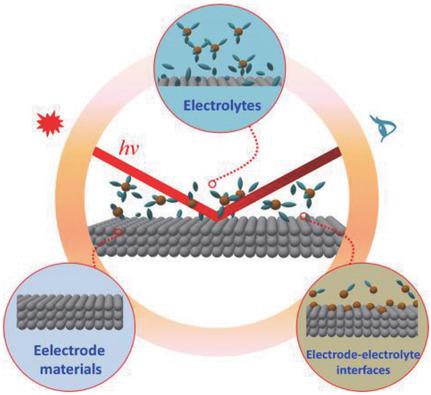当前位置:
X-MOL 学术
›
Small Methods
›
论文详情
Our official English website, www.x-mol.net, welcomes your
feedback! (Note: you will need to create a separate account there.)
Applications of Conventional Vibrational Spectroscopic Methods for Batteries Beyond Li‐Ion
Small Methods ( IF 10.7 ) Pub Date : 2018-03-26 , DOI: 10.1002/smtd.201700332 Yuanfu Deng 1 , Shengyang Dong 2, 3 , Zhifei Li 3 , Heng Jiang 3 , Xiaogang Zhang 2 , Xiulei Ji 3
Small Methods ( IF 10.7 ) Pub Date : 2018-03-26 , DOI: 10.1002/smtd.201700332 Yuanfu Deng 1 , Shengyang Dong 2, 3 , Zhifei Li 3 , Heng Jiang 3 , Xiaogang Zhang 2 , Xiulei Ji 3
Affiliation

|
Advanced energy‐storage devices are in tremendous demand to meet the ever‐growing electrification of the economy. To design batteries, it is critical to understand the evolving structures of the electrode materials, the compositions of the solid electrolyte interphase, and the reaction intermediates during the electrochemical processes. To this end, a plethora of characterization techniques are employed in battery research to bridge the fundamental understanding to practical optimization of battery systems. Vibrational spectroscopy methods, including Raman spectroscopy, and Fourier transform infrared (FTIR) spectroscopy are powerful analytic tools for the purposes of battery studies. Here, the usage of Raman and FTIR spectroscopy techniques for secondary batteries, such as lithium‐ion batteries, lithium–sulfur batteries, lithium–oxygen batteries, sodium‐ion batteries, and potassium‐ion batteries, is described.
中文翻译:

常规振动光谱法在锂离子电池以外的电池中的应用
为了满足经济不断增长的电气化需求,对先进的储能设备有巨大的需求。设计电池时,至关重要的是要了解电极材料的演变结构,固体电解质中间相的组成以及电化学过程中的反应中间体。为此,在电池研究中采用了大量的表征技术,以将基本理解与电池系统的实际优化联系起来。振动光谱法(包括拉曼光谱法和傅里叶变换红外(FTIR)光谱法)是用于电池研究的强大分析工具。在这里,拉曼光谱和FTIR光谱技术用于二次电池,例如锂离子电池,锂硫电池,锂氧电池,
更新日期:2018-03-26
中文翻译:

常规振动光谱法在锂离子电池以外的电池中的应用
为了满足经济不断增长的电气化需求,对先进的储能设备有巨大的需求。设计电池时,至关重要的是要了解电极材料的演变结构,固体电解质中间相的组成以及电化学过程中的反应中间体。为此,在电池研究中采用了大量的表征技术,以将基本理解与电池系统的实际优化联系起来。振动光谱法(包括拉曼光谱法和傅里叶变换红外(FTIR)光谱法)是用于电池研究的强大分析工具。在这里,拉曼光谱和FTIR光谱技术用于二次电池,例如锂离子电池,锂硫电池,锂氧电池,











































 京公网安备 11010802027423号
京公网安备 11010802027423号